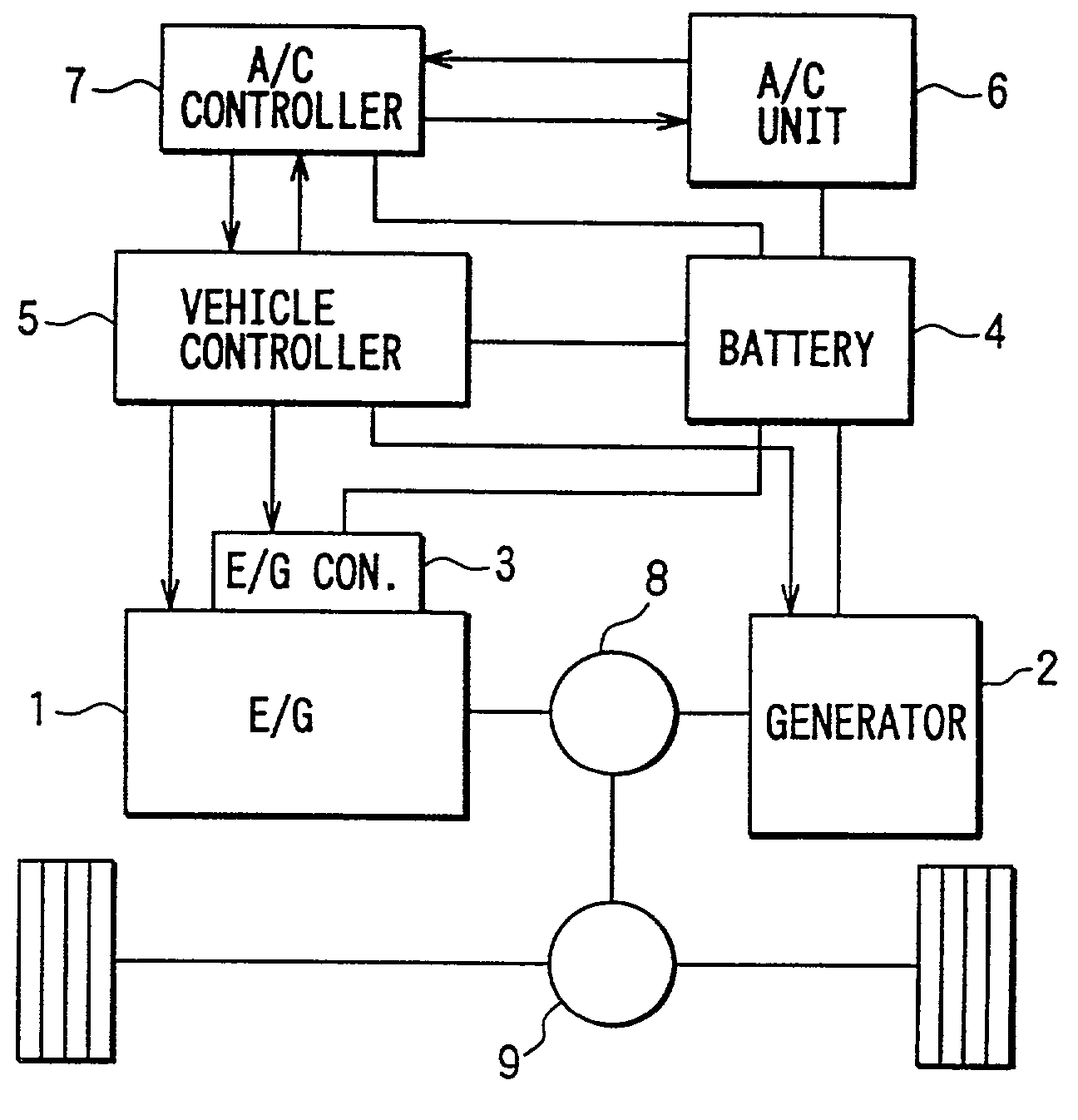[0008] It is another object of the present invention to reduce frequent for driving an engine, only for charging a battery, in an air conditioner for a
hybrid vehicle where the engine is controlled to be driven and stopped according to a vehicle running condition.
[0009] According to the present invention, in a
hybrid vehicle having an engine for running the vehicle and an electrical
motor generator for running the vehicle and for generating electrical power, when a residual charging degree of a battery becomes equal to or lower than a target degree, the electrical motor generator is driven by the engine to charge the battery. In addition, the target degree of the battery is set higher while the engine is driven, than the target degree of the battery while the engine is stopped. Because the target degree for starting the charging of the battery is set higher only while the engine is driven, the charging of the battery tends to be required while the engine is driven. On the other hand, while the engine is stopped, the charging of the battery tends not to be required. Therefore, the frequency for starting the engine only for charging the battery becomes lower. Generally, the engine
thermal efficiency becomes higher as an engine load increases. Accordingly, the engine
thermal efficiency becomes higher when the engine is driven for running the vehicle and for charging the battery, than the engine
thermal efficiency when the engine is driven only for charging the battery. Thus, the engine is driven while having a high engine thermal efficiency, thereby improving fuel consumption efficiency and reducing an exhaust amount of environmental polluting matter.
[0010] Preferably, when an output of the engine is equal to or higher than a predetermined value, the target degree is set higher than that when the output of the engine is lower than the predetermined value. Alternatively, when a vehicle speed is equal to or lower than a predetermined speed, the target degree is set lower than that when the vehicle speed is higher than the predetermined speed. Alternatively, the target degree is set higher in a first running mode where a possibility for driving the engine is high, than that in a second running mode where the possibility for driving the engine is low. Alternatively, when a discharging degree of the battery is equal to or higher than a predetermined degree, the target degree is set lower than that when the discharging degree of the battery is lower than the predetermined degree. Accordingly, even in those cases, the fuel consumption efficiency can be effectively improved.
[0011] Preferably, the target degree is set higher as the air-conditioning necessary electrical power increases. Therefore, the charging degree of the battery can be increased with the increase of the air-conditioning necessary electrical power, while a time for which the engine can be continuously stopped can be made longer.
[0012] On the other hand, according to the present invention, air-conditioning capacity of the
air conditioning unit is set lower while the engine is stopped than the air-conditioning capacity while the engine is driven. Accordingly, while the engine is stopped,
electrical load applied to the battery becomes low, so that the charging of the battery tends not to be required. Thus, the frequency for starting the engine only for charging the battery is reduced further, thereby improving fuel consumption efficiency and reducing the exhaust amount of environmental polluting matter. While the engine is driven, the air-conditioning performance of the
air conditioning unit is set higher to improve an amenity in a passenger compartment of the vehicle.
[0013] Preferably, when a vehicle speed is equal to or lower than a predetermined speed, the air-conditioning capacity of the
air conditioning unit is set lower than that when the vehicle speed is higher than the predetermined speed. Alternatively, when a discharging degree of the battery is equal to or higher than a predetermined degree, the air-conditioning capacity of the air conditioning unit is set lower than that when the discharging degree of the battery is lower than the predetermined degree. Alternatively, the air-conditioning capacity of the air conditioning unit is set lower in the first running mode where the possibility for driving the engine is low, than that in the second running mode where the possibility for driving the engine is high. Alternatively, when the residual charging degree of the battery is equal to or lower than a predetermined charging degree that is higher than the target degree, the air-conditioning capacity of the air conditioning unit is set lower than the air-conditioning capacity when the residual charging degree of the battery is higher than the predetermined charging degree. Alternatively, when a rotation speed of the engine is equal to or higher than a predetermined rotation speed, the air-conditioning capacity of the air conditioning unit is set lower than the air-conditioning capacity when the rotation speed of the engine is lower than the predetermined rotation speed. Alternatively, when a running load of the vehicle is equal to or higher than a predetermined load, the air-conditioning capacity of the air conditioning unit is set lower than the air-conditioning capacity when the running load is lower than the predetermined load. Alternatively, when the electrical motor generator is used for running the vehicle, the air-conditioning capacity of the air conditioning unit is set lower than the air-conditioning capacity when the electrical motor generator is used for generating electrical power. Accordingly, the frequency for starting the engine only for charging the battery is reduced, while the amenity in the passenger compartment of the vehicle can be effectively improved.
 Login to View More
Login to View More  Login to View More
Login to View More 


